👨💻作者简介:👨🏻🎓告别,今天
📔高质量专栏 :☕java趣味之旅
欢迎🙏点赞🗣️评论📥收藏💓关注
💖衷心的希望我的📙作品能给大家带来收获。
🎊前言:
让我们如大自然般🌱悠然自在😊地生活一天吧,
别因为有坚果外壳或者蚊子翅膀落在铁轨上🛤️而翻了车🚆。让我们该起床时🛏️就赶紧起床🛏️,
该休息🛏️时就安心休息🛏️,
保持安宁而没有烦扰的心态;身边的人要来就让他来,要去就让他去,
让钟声🕰️回荡,让孩子👼哭喊—
下定决心好好地过一天。
🙏希望大家都可以过好每一天。也🙏希望我的博客,能给大家带来💯收获。
1.String类的重要性
在C语言中已经涉及到字符串了,但是在C语言中要表示字符串只能使用字符数组或者字符指针,可以使用标准库提 供的字符串系列函数完成大部分操作,但是这种将数据和操作数据方法分离开的方式不符合面相对象的思想,而字符串应用又非常广泛,因此Java语言专门提供了String类。
在面试中也频繁被问到,比如:String、StringBuff和StringBulider之间的区别等。
2.String的常用方法
2.1 字符串构造
String类提供的构造方式非常多,常用的就以下三种:
public static void main(String[] args) {
// 使用常量串构造
String s1 = "hello bit";
System.out.println(s1);
// 直接newString对象
String s2 = new String("hello bit");
System.out.println(s1);
// 使用字符数组进行构造
char[] array = {'h','e','l','l','o','b','i','t'};
String s3 = new String(array);
System.out.println(s1);
}
其他方法需要用到时,大家参考Java在线文档:String官方文档-传送口
【注意】:
1.String是引用类型,内部并不存储字符串本身,在String类的实现源码中,String类实例变量如下: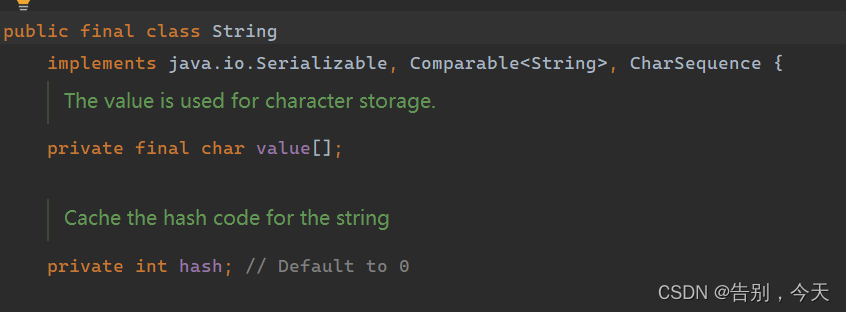
public static void main(String[] args) {
// s1和s2引用的是不同对象 s1和s3引用的是同一对象
String str = new String("hello");
String str1 = new String("hi");
String str3 = str;
String str2 = null;//st2这个引用 不指向任何对象;
String str4 = " ";
System.out.println(s1.length()); // 获取字符串长度---输出5
System.out.println(s1.isEmpty()); // 如果字符串长度为0,返回true,否则返回false
System.out.println(str2.isEmpty());//报空指针异常
System.out.println(str4.isEmpty());//true
}
//打印str3也是hello
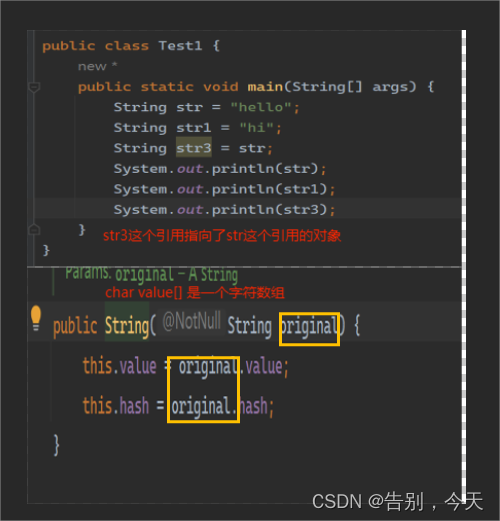

2. 在Java中“”引起来的也是String类型对象。
// 打印"hello"字符串(String对象)的长度
System.out.println("hello".length());
3. String对象的比较
字符串的比较是常见操作之一,比如:字符串排序。Java中总共提供了4中方式:
3.1 ==比较是否引用同一个对象
注意:对于内置类型,==比较的是变量中的值;对于引用类型==比较的是引用中的地址。
public static void main(String[] args) {
int a = 10;
int b = 20;
int c = 10;
// 对于基本类型变量,==比较两个变量中存储的值是否相同
System.out.println(a == b); // false
System.out.println(a == c); // true
// 对于引用类型变量,==比较两个引用变量引用的是否为同一个对象
String s1 = new String("hello");
String s2 = new String("hello");
String s3 = new String("world");
String s4 = s1;
System.out.println(s1 == s2); // false
System.out.println(s2 == s3); // false
System.out.println(s1 == s4); // true
}1. boolean equals(Object anObject) 方法:按照字典序比较
字典序:字符大小的顺序
String类重写了父类Object中equals方法,Object中equals默认按照==比较,String重写equals方法后,按照如下规则进行比较,比如: s1.equals(s2)
public boolean equals(Object anObject) {
// 1. 先检测this 和 anObject 是否为同一个对象比较,如果是返回true
if (this == anObject) {
return true;
}
// 2. 检测anObject是否为String类型的对象,如果是继续比较,否则返回false
if (anObject instanceof String) {
// 将anObject向下转型为String类型对象
String anotherString = (String)anObject;
int n = value.length;
// 3. this和anObject两个字符串的长度是否相同,是继续比较,否则返回false
if (n == anotherString.value.length) {
char v1[] = value;
char v2[] = anotherString.value;
int i = 0;
// 4. 按照字典序,从前往后逐个字符进行比较
while (n-- != 0) {
if (v1[i] != v2[i])
return false;
i++;
}
return true;
}
}
return false;
}
public static void main(String[] args) {
String s1 = new String("hello");
String s2 = new String("hello");
String s3 = new String("Hello");
// s1、s2、s3引用的是三个不同对象,因此==比较结果全部为false
System.out.println(s1 == s2); // false
System.out.println(s1 == s3); // false
// equals比较:String对象中的逐个字符
// 虽然s1与s2引用的不是同一个对象,但是两个对象中放置的内容相同,因此输出true
// s1与s3引用的不是同一个对象,而且两个对象中内容也不同,因此输出false
System.out.println(s1.equals(s2)); // true
System.out.println(s1.equals(s3)); // false
}2. int compareTo(String s) 方法: 按照字典序进行比较
与equals不同的是,equals返回的是boolean类型,而compareTo返回的是int类型。具体比较方式:
1. 先按照字典次序大小比较,如果出现不等的字符,直接返回这两个字符的大小差值
2. 如果前k个字符相等(k为两个字符长度最小值),返回值两个字符串长度差值
public static void main(String[] args) {
String s1 = new String("abc");
String s2 = new String("ac");
String s3 = new String("abc");
String s4 = new String("abcdef");
System.out.println(s1.compareTo(s2)); // 不同输出字符差值-1
System.out.println(s1.compareTo(s3)); // 相同输出 0
System.out.println(s1.compareTo(s4)); // 前k个字符完全相同,输出长度差值 -3
}比较大小的时候对应字符进行比较
1.对应字符不一样,就看对应字符的Ascll码值
2.对应字符长度不一样,返回值是对应的Ascll码的差值
3. boolean equalsIgnoreCase(Object anObject) 方法:与equals方式相同,但是忽略大小写比较
public static void main(String[] args) {
String s1 = new String("abc");
String s2 = new String("ABc");
System.out.println(s1. equals(s2)); // fase
System.out.println(s1. equalsIgnoreCase(s2)); // true
}4. int compareToIgnoreCase(String str) 方法:与compareTo方式相同,但是忽略大小写比较
public static void main(String[] args) {
String s1 = new String("abc");
String s2 = new String("ac");
String s3 = new String("ABc");
String s4 = new String("abcdef");
System.out.println(s1.compareToIgnoreCase(s2)); // 不同输出字符差值-1
System.out.println(s1.compareToIgnoreCase(s3)); // 相同输出 0
System.out.println(s1.compareToIgnoreCase(s4)); // 前k个字符完全相同,输出长度差值 -3
}4. 字符串查找
字符串查找也是字符串中非常常见的操作,String类提供的常用查找的方法:
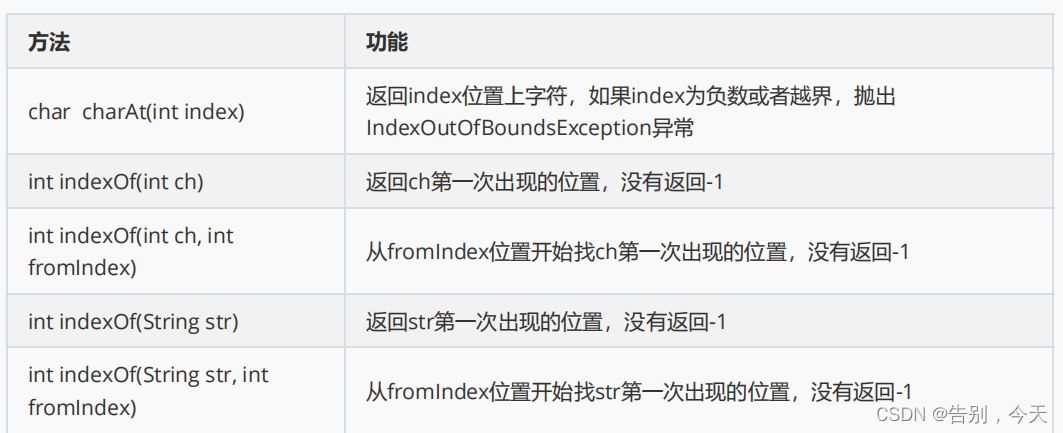
public static void main(String[] args) {
String s = "abcdefg";
System.out.println(s.charAt(3));//返回下标为3的字符d
System.out.println(s.charAt(-1));//报错
System.out.println(s.charAt(100));//报错 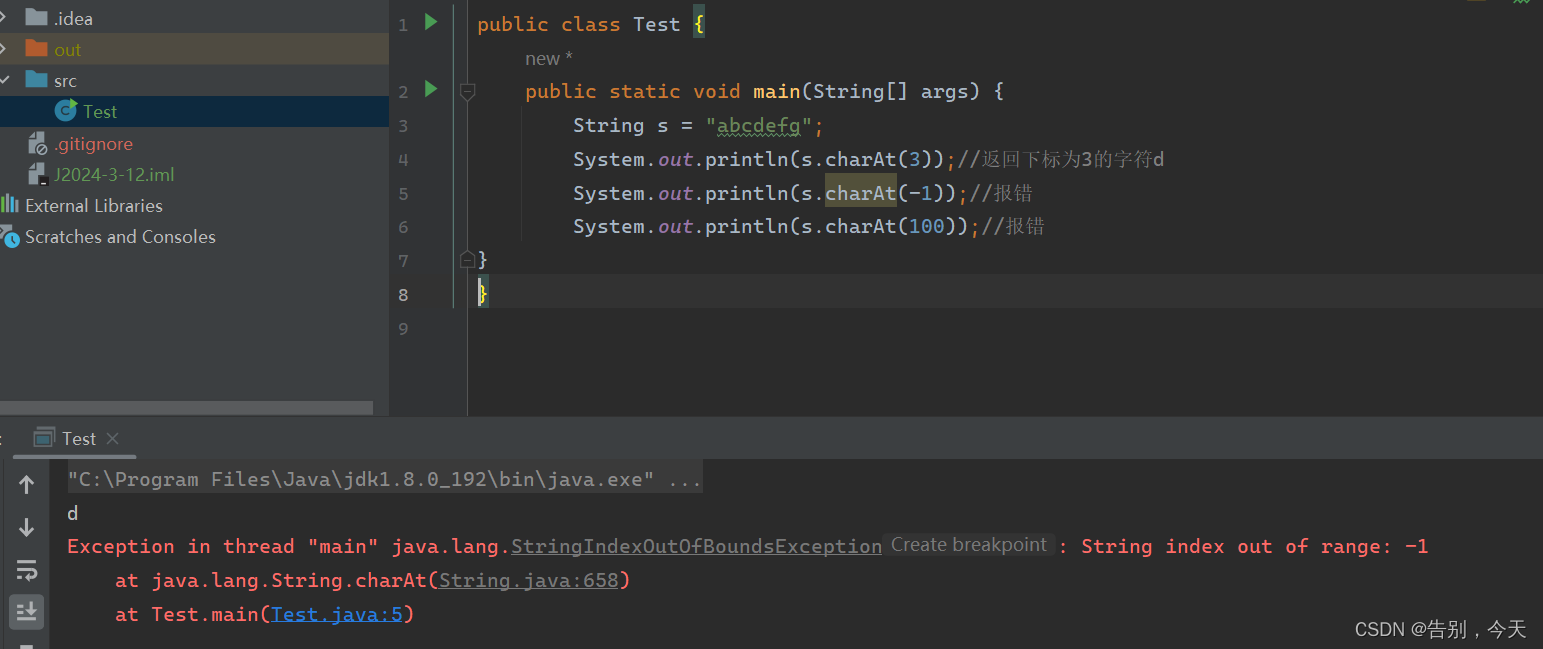
public static void main(String[] args) {
String s = "aaabbbcccaaabbbccc";
System.out.println(s.indexOf('c'));//默认从0开始,返回对应字符出现的下标位置,从头开始一个一个查。6
System.out.println(s.indexOf('c', 10)); //从10位置开始找c第一次出现的位置 15
System.out.println(s.indexOf("bbb")); // 从一个字符串找另一个字符串 3
System.out.println(s.indexOf("bbb", 10)); //从10位置开始找bbb第一次出现的位置 12 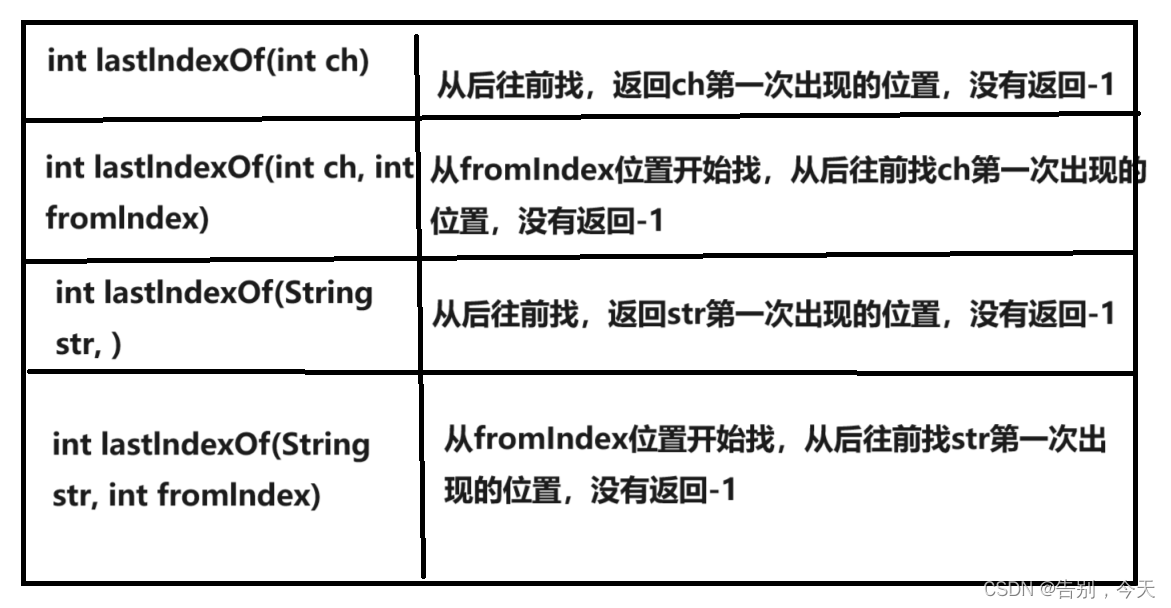
public static void main(String[] args) {
String s = "aaabbbcccaaabbbccc";
System.out.println(s.lastIndexOf('c')); //从后往前找c的位置 17
System.out.println(s.lastIndexOf('c', 10)); //从10下标位置往前找c的位置 8
System.out.println(s.lastIndexOf("bbb")); // 12
System.out.println(s.lastIndexOf("bbb", 10)); // 35. 字符串的转化
1. 数值和字符串转化
public static void main(String[] args) {
// 数字转字符串
String s1 = String.valueOf(1234);
String s2 = String.valueOf(12.34);
String s3 = String.valueOf(true);
String s4 = String.valueOf(new Student("Hanmeimei", 18));
System.out.println(s1);
System.out.println(s2);
System.out.println(s3);
System.out.println(s4);//发生了序列化
System.out.println("=================================");
// 字符串转数字
// 注意:Integer、Double等是Java中的包装类型,这个后面会讲到
int data1 = Integer.parseInt("1234");
double data2 = Double.parseDouble("12.34");
System.out.println(data1);
System.out.println(data2);
}补充:
包装类:首先是一个类,其次类中有更多的方法,使用起来更方便
序列化是指把对象转化为字符串
反序列化,是指把字符串转化为对象
2. 大小写转换
public static void main(String[] args) {
String s1 = "hello";
String s2 = "HELLO";
// 小写转大写
System.out.println(s1.toUpperCase());
System.out.println(s1);//为什么依然输出hello
// 大写转小写
System.out.println(s2.toLowerCase());
}以上的转换不是在原来的字符串进行转换,而是生成一个新的。因为在JAVA中String是不可变的
3. 字符串转数组
public static void main(String[] args) {
String s = "hello";
// 字符串转数组
char[] ch = s.toCharArray();
for (int i = 0; i < ch.length; i++) {
System.out.print(ch[i]);
}
System.out.println();
// 数组转字符串
String s2 = new String(ch);
System.out.println(s2);
}4. 格式化
public static void main(String[] args) {
String s = String.format("%d-%d-%d", 2019, 9,14);
System.out.println(s);
}
🎊总结
以上就是对String的简单介绍以及简单方法的运用,后面就会讲关于String的一些oj题和进阶方法。




)
——dfs/bfs)






一面30min)

基于lora参数微调Qwen1.8chat模型的实战教程)




